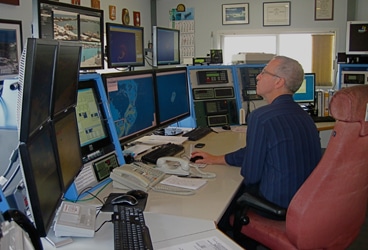
Towering in the middle, like a castle keep surrounded by a dry moat, stood a stark white building whose roof bristled with antennae. For sailors this is a bit like Mecca—the home of Bermuda Radio. We had called ahead to get a tour, and Denis Rowe, Chief Maritime Operations Controller, was happy to oblige.
Martin Williams, the officer on duty, sat behind a phalanx of screens and radios, the nerve center of all maritime operations in and near Bermuda. Bright green slashes on the monitors showed the positions of all vessels within the various radars’ eyes, while on enormous wall charts of the North Atlantic through the West Indies, red lines designated search-and-rescue areas of all agencies. About a thousand yachts a year, as well as all ships and tugs, are monitored from the moment they approach Bermudian waters until they leave, and while some may balk at this sort of Big Brotherly attention, I’ve never found it oppressive. These are the people who will help guide a ship or boat through or around the reef if it’s in trouble, or send a search-and-rescue boat out to find you if you’re lost or disabled. They’re famous in sailing circles for their cool heads and calm voices in tense situations. “All of our guys are former deck officers, merchant officers, and merchant mariners,” Rowe said. “They all have a solid background, and that’s because only one person is on watch. We want the voice on the radio to be calm and assured. People say, ‘We heard your voice and it was so reassuring,’ and that’s what it’s all about. There’s a very high bar here and we want to keep it there.”
“I’m a coiled spring,” said Williams, with the same dry wit he used to describe being on duty during Hurricane Fabian, which rampaged across the island as a category three storm in 2003. Four people were swept to their deaths off the causeway connecting St. David’s to the main island, and wind speeds reached 147 knots. “It was windy, yeah,” Williams said, “gentle zephyrs. I was up here for 32 hours. The antennae mast came down with a bit of a clunk, and it had the anemometer on it.”








